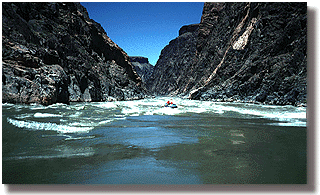PRECAMBRIAN CRYSTALLINE CORE
 |
| Fig. 5 |
The sedimentary sequences of the Grand Canyon sit atop the Precambrian
crystalline core. This foundation rock represents some very remarkable
events geologically speaking. Primarily the accreation of several
microplates or orogenic belts between 2.0 and 1.6 billion years ago,
which created Laurentia, the North American craton. After the craton
was assembled it was perforated by tremendous volumes plutonic rock,
this was apparently generated by the heat associated with a mantle
"superswell" or large zone of upwelling.
The only signs of life within the core are discontinuous layers or
lenses of carbonate within the Vishnu Metamorphic Complex. This
material was most likely algal mats, the only evidence of life in the
Proterozoic Vishnu sea.







